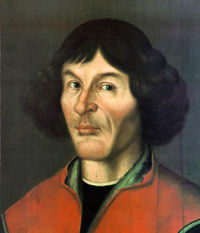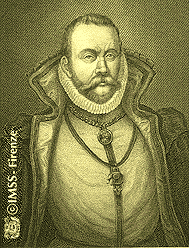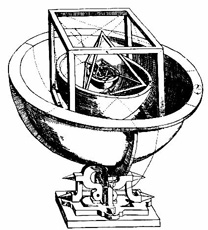
 |
Of all the great thinkers of the golden age of Greece, perhaps the one most revered was Aristotle who lived during the fourth century B.C. A student of Plato, Aristotle taught at the Lyceum for much of his career until political events caused him to emigrate to Macedonia. |
One
of the great misconceptions of the events of history is the idea
that, in the time of Columbus, learned people believed that the
Earth was flat. In fact, Eratosthenes, a Greek citizen who became
the director of the great library in Alexandria during the third
century B.C., was able to demonstrate that the Earth was spherical
and in fact determined the radius of the Earth with remarkable
precision. He had determined that, on the day of the
summer solstice, the sun shone on the bottom of a vertical well
in Cyene (now called Aswan) in Egypt. On the same day in Alexandria,
which he believed to be directly north of Cyene, the sun's rays
struck the side of the well at an angle of 7 degrees. He
caused to be measured the distance between the two wells (which
is several hundred miles). By knowing the angle and the arc length
of the distance between the wells, he was able to determine the
first estimate of the size of the Earth.
http://galileo.phys.virginia.edu/classes/109N/lectures/gkastr1.html
A
model of the universe that puts the Earth at the center of everything
is said to be geocentric. The single piece of writing that
best describes the geocentric view as seen by the Greeks is the
Almagest written by Claudius Ptolemy in Alexandria in the
second century AD. His was a very complicated piece of work that
tried desperately to fit the motion of heavenly bodies to the
plan that Aristotle had suggested, namely that the planets coursed
through the heavens in circular orbits at constant speeds. Most
of the lights in the sky are the so-called fixed stars which
maintain their relative position as seen from Earth while rotating
en masse across the evening sky. The motion of the planets
(from the Greek word planetai for wandering stars) proved
more troublesome. Their paths through the heavens did not easily
conform to Aristotle's circles. The planets exhibit the phenomenon
known as retrograde
motion wherein
the planet stops its eastward trek across the sky and travels
west for several days. (Understand that the planets are not doing
dramatic loop-de-loops in the heavens. Retrograde motion occurs
over a sufficiently long period that only a diligent astronomer
would notice.) Ptolemy persisted in making planetary pathways
fit a eccentric model by making extensive use of a construction
called an epicycle wherein the planet leaves the circular
track it is supposed to have and moves through a smaller circle
whose center follows the path of the planet on the original circle.
Sometimes there were epicycles on epicycles --very, very complicated.
But that only added to its worth because only the learned folk
in society could understand it.
Nicholas Copernicus
 |
One of the great learned men of his time, Nicholas Copernicus was a mathematician, astronomer, jurist, physician, classical scholar, Catholic cleric, governor, administrator, military leader, diplomat and economist. It was during his work in astronomy that he concluded that the geocentric model of the universe had too many holes in it to stand any serious scrutiny. He found a heliocentric model to be far more pleasing to his Renaissance mind. He wrote about his findings in a book De Revolutionibus Orbium Coelestrum. Being fearful of retribution by the catholic church, it is said that he published the book from his deathbed. The book created a firestorm in the church--it was on the Index of Forbidden Books for more than 200 years. |
 |
Tycho Brahe Tycho Brahe led a very interesting life. Born to Danish nobility, he was given an island off the coast of Denmark, the income from which provided him with the wherewithal to pursue his interest in astronomy. It still had not been decided whether the earth was at the center of our stellar neighborhood or the sun. He recognized that that question could be answered only when sufficient data had been collected regarding the planets. To that end he collected data (planetary positions and the like) for the next forty years. Along the way he developed many devices to facilitate his measurements. Later, when the telescope had been invented, astronomers found Tycho's measurements to be always on target; the newer technology could only add to his precision. Tycho was something of a compromiser
in his view of cosmology. In the so-called Tychonic system, he
put the Earth at the center of a lunar orbit and at the center
of a shell of fixed stars. The sun also orbited the Earth, but
the five planets orbited the sun. Part of the reason for such
a complicated system was the path taken by Mars. The red planet
did not want to conform to orbiting the Earth or the sun. In
1600, Tycho hired Johannes Kepler and instructed him to "wage
war on Mars". more about that later |
 |
|
Galileo
Galilei stands as the giant in history of whom Newton makes reference.
The story surrounding his life's work tells of great triumph as
he expands our view of our planetary neighborhood. It is also
a story of profound tragedy as his new view of the cosmos is crushed
under the heel of the Holy Order of the Inquisition. Any biographical
piece about Galileo is worth reading.
He was born to a wealthy family in Pisa in 1564. He was given
a very sound formal education as he prepared to be a doctor. It
is in this study of medicine that his interest was diverted first
to mathematics and later to astronomy. He learned of Kepler's
early findings about planets orbiting the sun in elliptical paths
at non-uniform speeds. At that time in 1604. all of the intellectual
community in Europe was agog at the sighting of a new light in
the heavens. Except for the planets plying their courses in the
heavens, it was thought that the sky was perpetual and unchanging.
The apparition, probably a super nova, prompted additional interest
in the heavens. Then, in 1609, news reached him that changed his
life forever. He learned of the construction in Leyden in the
Netherlands of a very primitive spy glass. His first attempt at
making a telescope pointed out some serious deficiencies. The
next model had a magnifying power of about 60x. When he trained
the device on the heavens, modern (as in: using more than the
naked eye) astronomy was born. He discovered, among other things:
 |
In triumph, he told the world of his discovery in 1611 in Siderius Nuncius (the Starry Messenger). Galileo may well be the first scientist, the first person to let experience be the arbiter of truth. While the natural philosophers of the time railed that the Jovian satellites could not exist, Galileo's reply was "look for yourself." |
By 1616, Galileo had become a thorn in the side of the church/state authority as it battled against the protestant reformation. Galileo was warned that he should neither hold nor defend the Coperincan view that the Earth orbited the sun. He believed he had some measure of immunity from this prohibition because of his political connections. He bided his time until a more liberal, forward thinking pope was elected. That man, he believed, was Barfeo Barbarini, Pope Urban VIII, an ally and friend in the college of cardinals from whence popes are named.
In 1632, he published Dialogues Concerning
Two Chief World Systems in which he supported the Copernican
view that the Earth revolves around the sun. Writing in dialogue
form was a common literary vehicle at the time. The scenario consisted
of (usually) three speakers: a proponent of the suggested idea,
an opponent, and a third party who
acted as a mediator between the two and usually kept the discussion
going.The proponent laid out the plan eloquently, aided as necessary
by the mediator. The opponent threw up all the counter-arguments
he could muster but to no avail.
The book passed scrutiny of the church censors; it secured no
fewer than four Imprimaturs.
When Urban VIII read the book he was
furious. He saw the opponent in the dialog as
a carricatuire of himself and was not pleased with the outcome.
Galileo was ordered to stand trial before the Order of the Holy
Inquisition. The rules for this trial were very much
different from the rules of a trial today. He was not
allowed to see the evidence presented against him; he was not
allowed to cross-examine witnesses; he was not allowed to make
a statement in his own defense. The tribunal consisted of
Cardinals and other high church officials. The prosecutor
was the brother of the Pope. IN 1633, Galileo was found
guilty of heresy and was forced to recant his belief that
the Earth orbited the sun He was placed under house arrest;
he was shown the instruments of torture as if they were to be
used; he was forbidden from publishing he was not allowed to talk
to Protestants. As he left the courtroom, a broken man,
he spoke under his breath, in Italian."E per se muove"
("but it does move")
The fundamental disagreement between Gallileo and the church/state
was more than just a question where is the Earth among its
solar system neighbors. The central question in this matter
is one of authority: who shall decide what a person is going to
believe. The accused was most prominent scientist in this time.
If anyone could advance the adoption of a sun-centered
planetary system, it was Galileo. When he was convicted of heresy,
lesser scientists dropped the matter The scientific tradition
in most Catholic states was crushed , never to be re-established.
See also http://www.hao.ucar.edu/public/education/sp/images/galileo.html
see also
http://galileo.phys.virginia.edu/classes/109N/lectures/galtel.htm
http://galileo.phys.virginia.edu/classes/109N/lectures/gal_life.htm
http://www.pbs.org/wgbh/nova/galileo
|
From this work we may draw certain conclusions: 1.Never underestimate the intellect of ancient people. It took a powerful mathematician to work this complex problem without computers, without calculators, without even a slide rule. 2. Renaissance people were driven a need to find order in the universe.
In 1601 he found the answer. He took
the bold step of abandoning the circle and concluded that Mars
(and by association the other planets) traveled about the sun in an elliptical
orbit. The reason that that fact had
gone unnoticed for all this time was that the eccentricity of
the known planetary orbits was so small. Mars has an eccentricity
of orbit of the order of .09. Kepler's third law is rather curious. the three laws are usually listed together even though the third law was discovered in 1620, some 18 years after the first two. It says that for any planet orbiting the sun, the square of the orbital period to the cube of the mean distance from sun to planet is a constant. Symbolically, T^2/R^3 = k Here are the numbers.
|

|
||||||||||||||||||||||||||||||||||||||||||||||||||||||||||||

|
Here's an applet dealing with Kepler's
third law.
http://Java
lab.Oregon.edu/dcaley/kepler/Kepler.html
http://www-groups.dcs.st-and.ac.uk/~history/Mathematicians/Kepler.html
http://www.kepler.arc.nasa.gov/kepler_sites.html
http://www.phy.mtu.edu/apod/ap960831.html
http://www.phys.virginia.edu/classes/109N/lectures/tycho.htm
http://www.kepler.arc.nasa.gov/johannes.html
Finally, some modern astronomy sites
http://astrosun.tn.cornell.edu/index.html
http://csep10.phys.utk.edu/astr162/lect/index.html
Lunar Phases Web Tool [Java]
http://www.calvin.edu/~lmolnar/moon/index.html
You will have oppertunity the learn about Newton; he is featured prominently in the section on universal gravitation.
Last edited 01/24/09